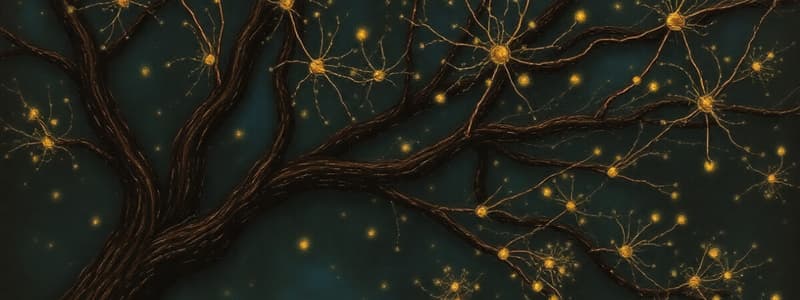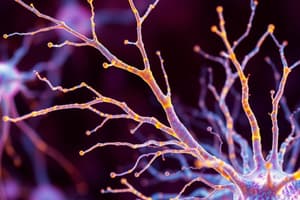Podcast
Questions and Answers
Which characteristic distinguishes electrical synapses from chemical synapses?
Which characteristic distinguishes electrical synapses from chemical synapses?
- Electrical synapses rely on neurotransmitters to transmit signals.
- Chemical synapses have gap junctions that allow direct ion flow.
- Chemical synapses facilitate faster signal transmission compared to electrical synapses.
- Electrical synapses allow for bidirectional signal transmission. (correct)
What is the role of 'active zones' in chemical synapses?
What is the role of 'active zones' in chemical synapses?
- They are regions where neurotransmitters are synthesized.
- They are located on the post-synaptic membrane to increase the surface area.
- They are sites on the pre-synaptic cell where neurotransmitters are released. (correct)
- They store neurotransmitters for future release.
During chemical synaptic transmission, what triggers the release of neurotransmitters into the synaptic cleft?
During chemical synaptic transmission, what triggers the release of neurotransmitters into the synaptic cleft?
- Efflux of potassium ions ($K^+$).
- Efflux of chloride ions ($Cl^-$).
- Influx of sodium ions ($Na^+$).
- Influx of calcium ions ($Ca^{2+}$). (correct)
What distinguishes ionotropic receptors from metabotropic receptors in chemical synapses?
What distinguishes ionotropic receptors from metabotropic receptors in chemical synapses?
Why are chemical synapses considered more 'plastic' compared to electrical synapses?
Why are chemical synapses considered more 'plastic' compared to electrical synapses?
Small-molecule neurotransmitters are synthesized in axon terminals from metabolic precursors, how are neuropeptides synthesized?
Small-molecule neurotransmitters are synthesized in axon terminals from metabolic precursors, how are neuropeptides synthesized?
Which of the following best describes the fate of neurotransmitters after they have been released into the synaptic cleft?
Which of the following best describes the fate of neurotransmitters after they have been released into the synaptic cleft?
Which of the following is an example of a small-molecule neurotransmitter?
Which of the following is an example of a small-molecule neurotransmitter?
What is a primary role of vesicular transporter molecules found on the surface of synaptic vesicles?
What is a primary role of vesicular transporter molecules found on the surface of synaptic vesicles?
In the context of neurotransmitter release, what is 'exocytosis'?
In the context of neurotransmitter release, what is 'exocytosis'?
What is the functional difference between an excitatory post-synaptic potential (EPSP) and an inhibitory post-synaptic potential (IPSP)?
What is the functional difference between an excitatory post-synaptic potential (EPSP) and an inhibitory post-synaptic potential (IPSP)?
How does the nervous system ensure specificity in the effects of neurotransmitters, like acetylcholine, on different target cells?
How does the nervous system ensure specificity in the effects of neurotransmitters, like acetylcholine, on different target cells?
If a neuron releases both a small-molecule neurotransmitter and a neuropeptide, what is this an example of?
If a neuron releases both a small-molecule neurotransmitter and a neuropeptide, what is this an example of?
What is the main function of 'dynamin' in the context of neurotransmitter release and vesicle recycling?
What is the main function of 'dynamin' in the context of neurotransmitter release and vesicle recycling?
How are neuropeptides transported from the cell body to the axon terminals?
How are neuropeptides transported from the cell body to the axon terminals?
Which functional class do most neurotransmitters primarily found in the CNS belong to?
Which functional class do most neurotransmitters primarily found in the CNS belong to?
What is one advantage of chemical synapses over electrical synapses?
What is one advantage of chemical synapses over electrical synapses?
What is the role of 'propeptides' in the synthesis and function of neuropeptides?
What is the role of 'propeptides' in the synthesis and function of neuropeptides?
Which of the following describes the process of 'kiss-and-run fusion' in neurotransmitter release?
Which of the following describes the process of 'kiss-and-run fusion' in neurotransmitter release?
Flashcards
What is a synapse?
What is a synapse?
Specialized site of communication between a neuron and another cell.
What is an electrical synapse?
What is an electrical synapse?
The current spreads directly from one cell to another, making it extremely fast. Cells are linked by gap junctions.
What is a chemical synapse?
What is a chemical synapse?
Action potential is transduced into a chemical signal (neurotransmitter) to cross the gap. Involves synaptic vesicles and active zones.
What are synaptic vesicles?
What are synaptic vesicles?
Signup and view all the flashcards
What are active zones?
What are active zones?
Signup and view all the flashcards
What are post-synaptic densities?
What are post-synaptic densities?
Signup and view all the flashcards
What are ionotropic receptors?
What are ionotropic receptors?
Signup and view all the flashcards
What are metabotropic receptors?
What are metabotropic receptors?
Signup and view all the flashcards
What are the advantages of chemical synapses?
What are the advantages of chemical synapses?
Signup and view all the flashcards
What are small-molecule neurotransmitters?
What are small-molecule neurotransmitters?
Signup and view all the flashcards
What are neuropeptides?
What are neuropeptides?
Signup and view all the flashcards
What are the steps of neurotransmitter release?
What are the steps of neurotransmitter release?
Signup and view all the flashcards
What is a postsynaptic potential (PSP)?
What is a postsynaptic potential (PSP)?
Signup and view all the flashcards
What is excitation in synaptic potentials?
What is excitation in synaptic potentials?
Signup and view all the flashcards
What is inhibition in synaptic potentials?
What is inhibition in synaptic potentials?
Signup and view all the flashcards
Study Notes
Introduction to Synapses
- A synapse is a specialized site where a neuron communicates with another cell
- Synapses can occur between two neurons, a neuron and an effector cell, or a sensory cell and a neuron
- Presynaptic neurons impact the function of postsynaptic cells
- Action potentials in the presynaptic cell trigger the release of a synaptic transmission
- Synaptic transmission is the signal sent by the presynaptic cell to affect the postsynaptic cell
- Synaptic transmissions alter the membrane potential of the postsynaptic cell, either increasing or decreasing the likelihood of an action potential
Electrical Synapses
- Synapses are more commonly chemical, but some are electrical
- Chemical and electrical synapses serve different functional roles
- In an electrical synapse, the action potential spreads directly from one cell to another, making it extremely fast
- Cells using electrical synapses have specialized gap junctions
- Protein channels called connexons bridge the gap between cells, linking their cytoplasm
- Connexons bring the cells about 3.5 nm apart
- Electrical signals weaken slightly as they move from one cell to another
- Electrical synapses are used in escape circuits, such as the crawfish tail-flip
Chemical Synapses
- In chemical synapses, the action potential in the presynaptic cell is transduced into a chemical signal (neurotransmitter)
- Neurotransmitters are sent to the postsynaptic cell across the gap between the cells
- Synaptic vesicles in the presynaptic cell store thousands of neurotransmitter molecules
- Presynaptic cells have active zones where neurotransmitters are released
- The postsynaptic membrane possesses postsynaptic densities
- Receptor proteins for neurotransmitters are located in the postsynaptic densities
- Chemical synapses are separated from other cells by a 20 to 30 nm space called the synaptic cleft
Basic Steps of Chemical Synapses
- An action potential depolarizes the presynaptic terminal, opening voltage-gated Ca2+ channels
- Ca2+ moves into the cell because its concentration is lower inside than outside
- Ca2+ influx triggers neurotransmitter release into the synaptic cleft via calcium-dependent exocytosis
- Exocytosis is the fusion of synaptic vesicles to the presynaptic membrane
- Neurotransmitter molecules bind to specific receptor proteins embedded in the postsynaptic membrane
- Enzymes degrade neurotransmitters, or they are taken back into the presynaptic cell
- Neurotransmitter molecules travel across the synaptic cleft in 20-50 microseconds
Types of Chemical Synapses
- Synapse type is based on the receptor the neurotransmitter binds to
- Neurotransmitter receptor types are:
- Ionotropic receptors directly alter permeability to ions
- Ionotropic receptors produce rapid changes in membrane potential by allowing ions to flow into the cell and are ligand-gated ion channels
- Metabotropic receptors trigger a signaling cascade of second messengers in the postsynaptic cell and have slow but long-lasting effects
- Chemical synapses are slower than electrical synapses
Advantages of Chemical Synapses
- Chemical synapses can amplify the response in the postsynaptic cell
- Electrical synapses typically weaken from cell-to-cell
- Chemical synapses can be either excitatory or inhibitory
- Electrical synapses are nearly always excitatory
- Chemical synapses are more finely controlled and plastic than electrical synapses
- Presynaptic cells can release differing types or amounts of neurotransmitter and postsynaptic cells have different types and numbers of receptors
Classes of Neurotransmitters I
- Neurotransmitters are divided into two major classes
- Small-molecule neurotransmitters are usually single amino acids and their derivatives
- They are synthesized in axon terminals from metabolic precursors
- They are packaged into small synaptic vesicles by vesicular transporter molecules on the vesicle surface
- An example is dopamine, which is derived from tyrosine in the axon terminal
- They are released by calcium-dependent exocytosis
Classes of Neurotransmitters II
- Neuropeptides are chains of 3-55 amino acids
- They are synthesized on ribosomes in the neuronal cell body (soma) as propeptides, which contain several copies of neurotransmitter
- Large dense-cored vesicles transport the propeptides to the axon terminals
- Propeptides are cleaved inside these vesicles to make the active neurotransmitters
- The release of peptide neurotransmitters requires a higher frequency of presynaptic action potentials compared to small-molecule transmitters
- Exocytosis of these vesicles is not at active zones where Ca2+ enters, so greater Ca2+ influx is necessary
- Neuropeptides are always broken down after release
Neurotransmitter Functional Classes
- CNS neurotransmitters are divided into general functional classes based on their effect and location
- Most neurotransmitters in the CNS are small-molecule neurotransmitters
- Glutamate is mostly excitatory
- GABA and glycine are inhibitory
- Amines (acetylcholine, norepinephrine, dopamine, serotonin) are in fewer cells of the CNS, but are widespread
- They typically produce a slow response in postsynaptic cells
- Peptides are common in the CNS and are often released along with small-molecule neurotransmitters
Cotransmitters and the Evolution of Neurotransmitters
- Neurons can contain and release more than one kind of neurotransmitter
- Cotransmitters are neurotransmitters released by a single neuron
- Neurons often contain and release a small-molecule neurotransmitter and one or more neuropeptides
- Transmitters can be released from the same vesicle if they are the same type of neurotransmitter, such as dopamine and GABA
- Most neurotransmitters are conserved across animal taxa
Neurotransmitter Release
- Vesicles containing neurotransmitters are prepared by the cell
- After an influx of Ca2+ ions, vesicles dock with the axon membrane
- Vesicles will then either:
- Fuse fully with the membrane (classical exocytosis) and release neurotransmitter, or fuse only partially with the membrane (kiss-and-run fusion) and release neurotransmitter
- Retrieval of the vesicle
- In classical exocytosis, the vesicle is endocytosed with the aid of clathrin and dynamin
- In kiss-and-run fusion, the vesicle is not fully fused and does not need to undergo the full process of endocytosis
Synaptic Potentials
-
Postsynaptic potential (PSP) is generated in the postsynaptic cell after it binds neurotransmitters from a presynaptic cell
-
PSP is a short change in the resting membrane potential of the postsynaptic cell
-
Excitation is an increase in the probability that a cell will generate an action potential
-
It creates excitatory postsynaptic potentials (EPSPs)
-
Inhibition is a decrease in the probability that a cell will generate an action potential
-
It creates inhibitory postsynaptic potentials (IPSPs)
-
Changes in membrane potential in postsynaptic cells are controlled by changes in the permeability of the cell’s membrane to ions
-
When acetylcholine binds its receptor, the receptor (which is also an ion channel) opens and allows Na+ and K+ to enter/leave the cell more easily
-
Most neurotransmitters affect more than one kind of neurotransmitter receptor
-
The effects of a neurotransmitter depend on the type of receptors in the postsynaptic cell membrane
-
Acetylcholine excites skeletal muscle cells but inhibits heart muscle cells because these muscle cells have different receptors for acetylcholine
-
Nicotinic receptors are in skeletal muscle
-
Muscarinic receptors are in heart muscle
Studying That Suits You
Use AI to generate personalized quizzes and flashcards to suit your learning preferences.



